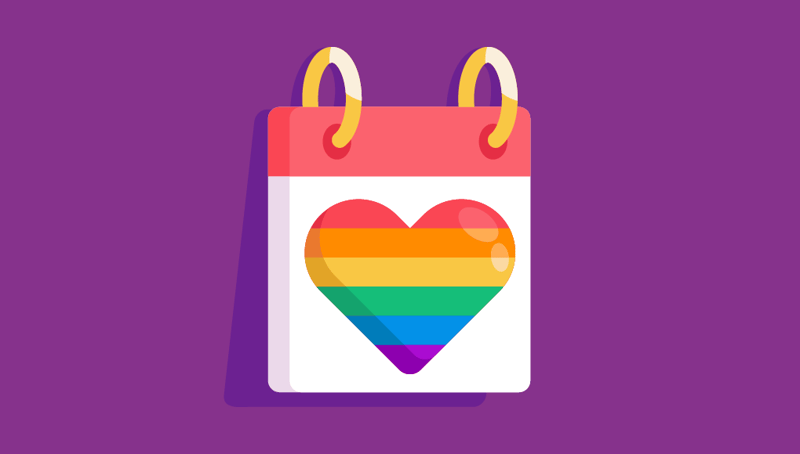Words are powerful.
It shouldn’t shock you to learn that I think that. I’m a writer after all.
But it’s not just me; think about how words have affected you. At their best, they can uplift, encourage, or inspire you. At their worst, they can defame, humiliate, or isolate you.
Words affect our students — and thus, the focus of our work — in these ways, too. So, it’s critical for you to consider the messages that you’re sending, especially as they relate to students’ identities and lived experiences.
I’m hopeful that no one reading this will seek to intentionally wield words as weapons that hurt others. You probably shun glaring insults and slang terms favored by bullies. Yet, many words aren’t so obviously “bad.” They may simply be outdated, have connotations you haven’t considered, or apply only to a more specific type of person than you’ve realized.
So, how can you do right by students, your colleagues, and your community?
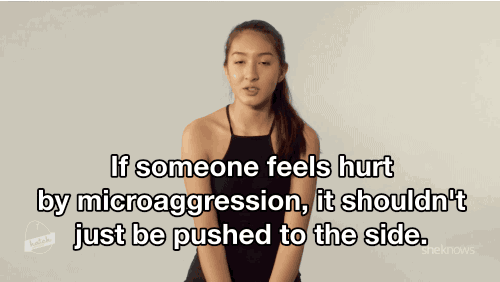
I suggest starting by educating yourself — considering history, current trends, and, most importantly, your students’ perspectives. Then, you can begin to craft language standards for yourself and others.
As this blog’s editor, I’ve created editorial standards for Presence’s posts. I won’t include the full guidelines here; it’s an over 57-page-long document and includes many snooze-worthy rules — like when to use a semicolon, the difference between em-dashes and en-dashes, and the definition of an independent clause. (Zzzzz… whoops, I bored myself.)
Instead, I’ll share some ideas on how you can go about creating your own language guide. Perhaps you’ll use it to keep your office, department, or even your entire institution in check. Or, it could simply be a way of educating yourself — a reminder to be thoughtful with each and every word choice you make.
As a quick note: I don’t consider myself an expert on identity language. And neither should you.
There’s no way to be an expert in something that changes so rapidly, as language norms do. But we can strive for our best — by consulting with new online resources, reading up on history, and staying curious and open-minded.
And above all, we can listen. If someone tells me that a word doesn’t sit comfortably with them, I adjust — even if my research tells me that it’s “right.” So should you.
Some of my suggestions below may not be ideal for you and your campus. Language varies by regions, cultures, and opinions. But I hope this can give you a starting point.
And though I’ll say it at the end, too, if you feel that I’ve gotten something wrong or you have a more nuanced insight to add, please let us know.
Gender
1. Sex vs. gender identity vs. gender expression
Learn the difference between these three terms and use them correctly.
Sex is a label assigned by a doctor at birth based on the genitals you’re born with and the chromosomes you have. It goes on your birth certificate.
But sex isn’t binary. An estimated 1.7% of people are intersex, meaning that they were born with genital anatomy that doesn’t seem to fit the typical definitions of female or male.
Gender identity is how a person sees themselves – their own internal sense and personal experience of gender. Many people have a gender identity of a man or woman, but some people do not.
Gender expression is how a person outwardly shows their gender identity. It includes physical expressions, such as a person’s clothing, hairstyle, makeup, and social expressions such as names and pronouns.
Remember also that sexuality and sexual orientation are different from these other three terms. Never use them interchangeably, and don’t assume a student’s sexual orientation based upon their gender expression or identity.
Here is another source that explains the gender spectrum and its many terms well.
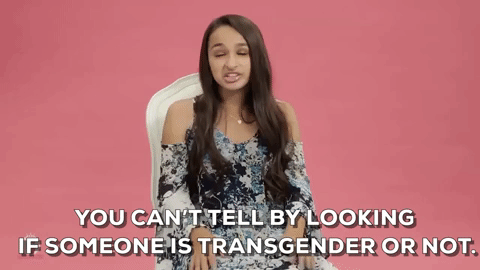
2. Personal pronouns
Before writing about any student, find out their pronouns. Some students might declare these in their email signatures and social media accounts.
Or, of course, you can simply ask them. Don’t make a big show of it, explaining that you’re not sure. Just ask, “What are your personal pronouns?” or include it as an open-ended question in a form.
You should never rely on official university documentation, for a few reasons. The student’s pronouns may have changed since they filled that out, they might have felt societal or familial pressure to select a different label, or your institution might only offer binary options.
Additionally, binary identities don’t necessarily correlate with the pronouns you might expect. For example, a woman might use they/them/their pronouns. Plus, not all non-binary folx use they/them/their. Ask, use, and respect these.
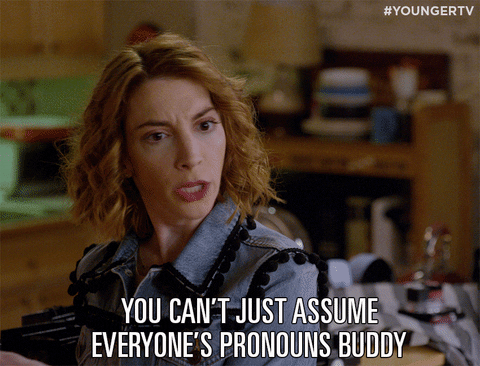
Note also that “preferred pronouns” is widely considered an outdated term. “Preferred” implies that there’s another acceptable option.
I, for example, prefer chocolate ice cream but I’ll still happily devour a vanilla sundae. I don’t, however, merely prefer she/her/hers pronouns. Those are my pronouns.
Just say pronouns. Drop the “preferred”.
3. Gendered terminology
Consider avoiding terms that have men or woman embedded with them (such as congressmen or mankind), as well as packaged binary expressions like waiters and waitresses, ladies and gentlemen, and men and women of the faculty.
Instead, opt for:
- Congressional representatives
- Humankind
- Waitstaff
- Esteemed guests
- Faculty members
You should always use non-gendered terms, not just when you happen to know that a non-binary individual will read or hear it. This inclusive behavior will help you get into the habit of rejecting binary norms and play a part in your allyship.
UNC Chapel Hill’s Writing Center shares additional examples of gendered language and suggests non-binary alternatives.
4. Coded language
Many English words have historically been used for only one gender, even without exclusively being defined by that gender. Consider, for example, the word boss. It subtly implies a man. So, go with supervisor or manager instead.
Be especially careful with adjectives. Would you use the words feisty, bossy, frigid, bombshell, or bubbly to describe someone of any gender? No? Then avoid them.
This is absolutely critical for job ads. Carefully consider how each and every word you use might subtly convey a gender bias.
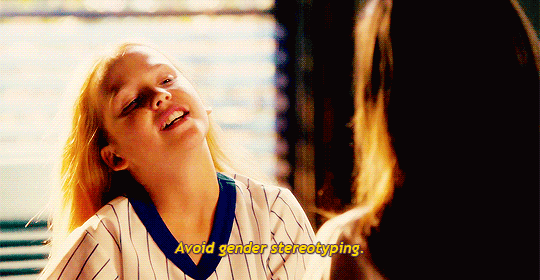
This can have an enormous impact on which folx decide to apply. So, educate yourself on coded language before crafting any job descriptions, student internship opportunities, or leadership ads. Advise local companies who recruit your students on this as well.
For example, dominate and ninja are largely male-coded in American society, meaning that ads with these words might discourage folx of other genders from applying. You can check yourself (or ahem, your language) here.
5. Derogatory terms
This one is fairly simple, and perhaps the most obvious: Don’t use derogatory gender terms.
Yet, it might not be so obvious which terms are derogatory. Words like transexual, transvestite, and sex change were historically popular, but today, most members of the transgender community view them as derogatory. (Though some reclaim the terms.)
Consult with resources like GLAAD, PFLAG, The Trans Language Primer, and your own LGBTQIA+ office to make informed language choices. And of course, be open to student feedback. If a student tells you that they find a word offensive or simply inaccurate — even if another resource approves of it — be flexible. Listen, adjust, and don’t take anyone’s feedback as a personal insult.
sexuality
6. No assumptions
You’re hopefully careful not to assume someone’s sexuality. But once you find out whom someone is dating or interested in, it might be tempting to label them.
For example, upon noticing a student (whom you know is female) cuddling a romantic partner, (whom you know is also female), you might assume that they’re both lesbians.
But, take a moment to assess that assumption, as it might not be true. One or either of them might be bisexual, pansexual, asexual, or otherwise queer. And, even if they are both exclusively attracted to women, the term lesbian might not resonate with them. They might identify with a different label, such as queer — or no label at all.
Never write about someone’s sexuality without confirming it with them and confirming that you have their permission to label them that way for others. Some students might be comfortable discussing their sexuality with you but don’t want other folx to know. Respect that.
7. Asexuality and aromanticism
Similarly, don’t assume that every student experiences sexual and/or romantic attraction — for any gender.
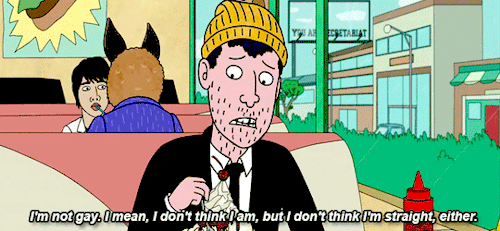
Approximately 1% of people are asexual, meaning that they don’t experience sexual attraction. There are also aromantic folx, AKA those who don’t experience romantic attraction. Some people are both asexual and aromantic but they’re not always a paired set; someone can experience one type of attraction but not the other.
So, what does that mean for inclusive language? As I explained in this post:
Statements like “it’s just human nature” or “everybody does it” related to sex and romance may be wonderfully affirming for many of your students, but it won’t be reflective of all students’ experiences. It can make asexual students feel like something is wrong with them, as if their feelings are inhuman or unnatural.
Some LGBTQIA+ offices may be able to help you better understand these concepts, but many are focused more on other marginalized sexual orientations. Professionals in these offices may have misconceptions about asexuality so it’s best to educate yourself, too.
8. Bisexuality and pansexuality
There are also many misconceptions about bisexuality and pansexuality.
Be sure to avoid language that implies that these identities are merely phases, that a bisexual or pansexual persona isn’t really bi or pan if they’re in a relationship with someone of a different gender, or that these individuals have straight privilege.
Bisexual and pansexual erasure is a rampant problem. Never use expressions like “whether you’re straight or gay,” which imply a false binary. And be sure to explicitly market all LGBTQIA+ programming as being bi- and pan-inclusive.
Then, follow up and make your programs that way. If not, these students might assume that no LGBTQIA+ programs are meant for them, and they won’t show up.
9. “Gay Pride Month”
What I’m about to type next might sound bizarre for a post on inclusivity, but hear me out: Don’t call June “Gay Pride Month” nor throw a “Gay Pride Parade.”
Why the heck not? Well, using the word “gay” erases the other letters within the LGBTQIA+ spectrum. It ignores lesbian, bisexual, pansexual, asexual, aromantic, and otherwise queer folx, as well as transgender, intersex, non-binary and genderqueer folx.
Show that June is about celebrating more folx than just cisgender gay men by calling it Pride Month or simply Pride.
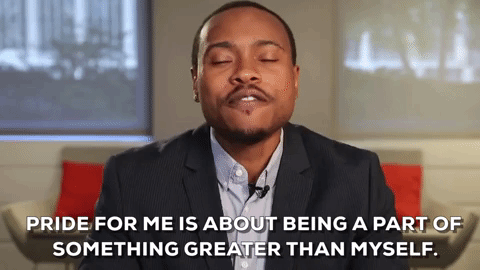
And you can acknowledge and celebrate these other LGBTQIA+ holidays, too!
Ability
10. Person-first… maybe
You may have heard that it’s best to use person-first language, as in students with autism rather than autistic students. Advocates of this rule say that no one should be defined by their disability. It’s something they have, not something they are.
But not all people, including many of those with disabilities, agree with this. They say that disability labels are not dirty words, and thus, we shouldn’t make sentence structures more complex to avoid them.
So, what should you do? I recommend talking to your disabilities service office about it. Ask about their language recommendations and the reasoning behind it.
And more importantly, be flexible. Before writing about an individual student, ask them about their language preference. Or, if a student tells you that your language was offensive, listen to them. Learn and adapt.
11. Pitying language
Don’t say that a student “suffers from blindness”, is “afflicted with muscular dystrophy”, or is “stricken with dyslexia.”
These verbs connote pity. And most folx with disabilities do not want to be pitied. They don’t view themselves as suffering, so you shouldn’t either.
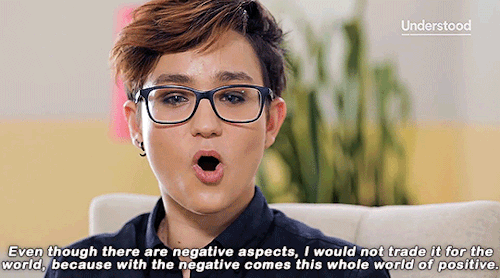
Instead, say “has” or “is” — as in a student “has muscular dystrophy” or “is blind.”
Similarly, don’t say that someone is “confined to a wheelchair” nor describe them as “wheelchair-bound.” Just say that they “use a wheelchair.”
12. Derogatory language
You hopefully know to avoid slurs like ret*rded, loony, and nuts. But here are some offensive labels that may be less obvious.
Note that some labels are totally fine to use when referring to someone with an applicable disability, but they shouldn’t be used otherwise. For example, you can refer to someone’s muscle spasms or motor coordination difficulties as spastic but don’t use as it an insult for someone who is clumsy.
Similarly, don’t frivolously refer to yourself or someone else as OCD. It’s a real mental health condition and shouldn’t be trivialized.
13. Ableist language and assumptions
Some words aren’t offensive in and of themselves, yet they still contribute to disability erasure.
For example, telling students to “walk around campus” ignores the fact that not everyone can walk. Instead, tell students in programs or in marketing materials to “explore campus.” And instead of telling students to “voice” or “write down” their ideas, use the words “express” or “communicate.”
Here’s the throughline: If there’s more than one way to physically achieve something, opt for language that covers many possibilities and accommodations.
Race and Ethnicity
14. “Minorities”
What could possibly be wrong with referring to students of color as “minority students”? Well, for one, at many institutions and within many communities, they aren’t the minority.
Many people also argue that the word implies powerlessness. It indicts a smaller role, perhaps even a less important one. It subtly belittles people and dismisses their needs.
It’s also extremely vague. Are these students in the minority for hating pizza? Loving long meetings? Being left-handed?
It can mean nearly anything. So quit hiding behind the code. Be specific. Say “students of color,” if you mean that. Use “black students” if you mean them more specifically. Or go with “students with historically marginalized identities” if you want to cover a wider breadth of students that, in addition to race, speaks to religion, gender, sexual orientation, disability status, and more.
15. Racial labels
Should you refer to a student as Latinx or Hispanic? Or how about Spanish? Is that OK?
The answer is: It depends.
For many racial, cultural, and ancestral labels, there’s no one unequivocally right selection that’s perfect for every student and group. Rather, the terms have different historical meanings and modern connotations.
Educate yourself so that you can use the terms correctly and understand why students may self-identify in the ways that they do. And as always, be open to changing and adapting based on student and colleague feedback.
Here are some resources to get you started:
As for Caucasian, scrap this from your vocabulary — unless you’re referring to people with ancestors from the Caucasus region, which includes the countries of Armenia, Azerbaijan, Georgia, Iran, Russia, and Turkey. (Yup, that means that many Caucasian people are dark-skinned.) Just use white.
And unless you’re describing a rug, expel the word oriental from your vocabulary, too. Use Asian, Asian American or a more specific descriptor, like Japanese American or a student with Filipino immigrant parents.

We ask many things of our students: To lead programs, to abide by conduct codes, and of course, to learn. So, we need to continue learning, too.
Language isn’t static, and neither are our students. But by always striving to use inclusive language, one thing can always remain true on our campus: We can always affirm their identities.
How have you shifted your language to support students? Is there anything critical I missed? Please let us know on Twitter @themoderncampus.



